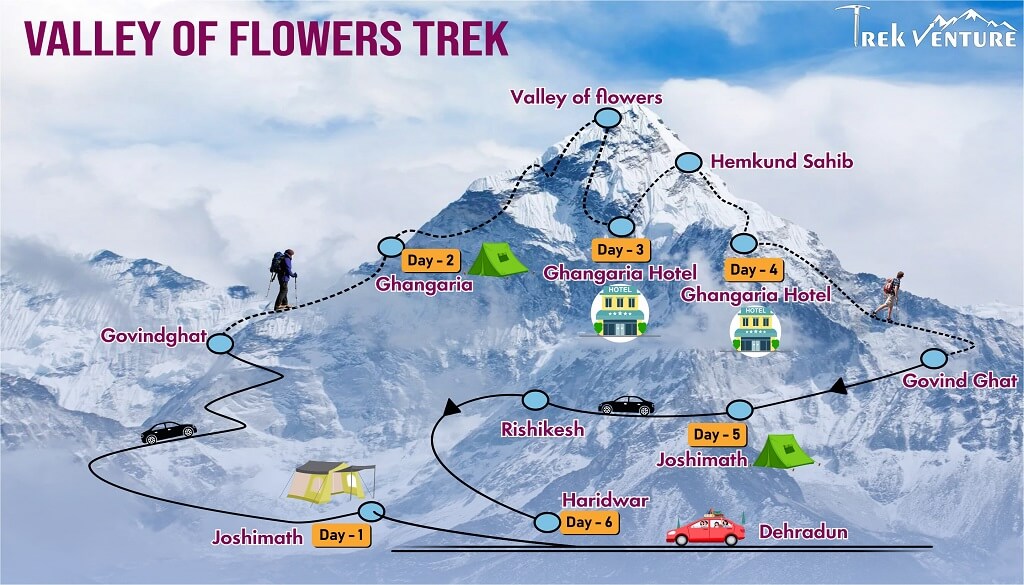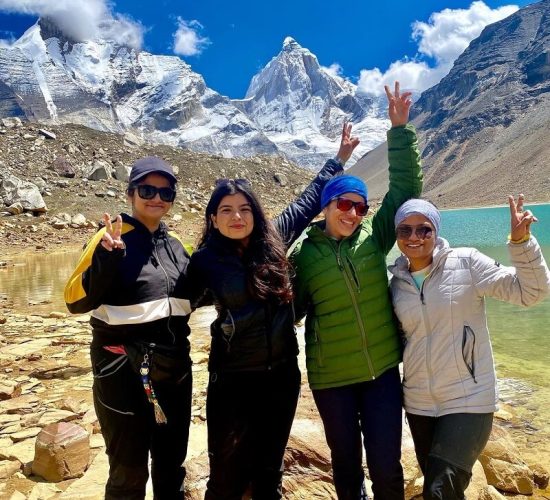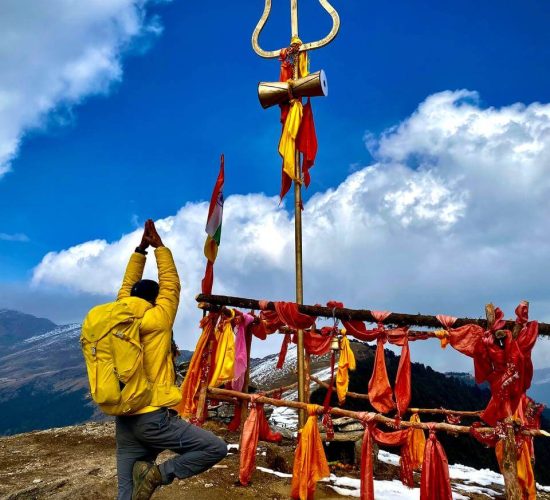Valley of Flowers Trek
6D – 5N | Dehradun to Haridwar
Enquire for Group Booking
↬ Description
- Altitude : 12000 ft.
- Duration: 6 Days
- Trek Length: 40km
- Base Camp: Joshimath
At an elevation of 3,600 metres above sea level and surrounded on all sides by snow-capped mountains, the Valley of Flowers is a magical region that can be found high in the Himalayas in the Indian state of Uttaranchal. Unbeknownst to mankind, for millennia this magnificent valley remained frozen during the course of the winter months. However, as soon as summer arrived, the snow began to melt, and the valley revealed its more youthful beauty once more. Every year, the valley was awash in colour as it blossomed with hundreds of different types of flowers, taking on varying hues of colour as the months proceeded. This gave the valley a vibrant appearance. Frank Smith, a climber, adventurer, and botanist, happened to stumble across it during the monsoon season of 1931. This was the day when nature finally acquiesced to humanity and bestowed upon them this wonderful sight. He was the author of the book “The Valley of Flowers,” which revealed the beauty and floral splendours of the valley and caused people all over the globe to take notice and pay attention. In 1982, it was designated a national park, and since then, it has been designated a World Heritage Site. Naturally, the villagers have always been aware of the valley’s presence, and they have long held the belief that fairies call the valley home.
↬ Itinerary
Day 1: Drive from Dehradun to Joshimath by taxi (256 Km) (10/11 Hours) (1,875 m/6152 feet)
The journey will get underway after we reach Dehradun. The journey to Joshimath will start when all of the trekkers are picked up from the Dehradun station and driven there. In order to go to Joshimath, we will follow the road that goes to Badrinath and pass via Rishikesh. We will also arrange for pick-ups at this point along the way. You will be awestruck by the breathtaking natural splendour that greets you along the road to Joshimath as you make your journey there. Be sure to have your camera with you at all times so that you don’t miss the chance to record some unforgettable and priceless moments. The nine-hour journey to Joshimath may leave you feeling exhausted, but just keep in mind that you will never be short of gorgeous and interesting things to see along the way. As we continue to ascend, the river that is flowing alongside you on the opposite side will get more turbulent while simultaneously becoming more intriguing. You will go via four of the Panchprayag, also known as the five happy links of the Ganga, on your way to Joshimath. These four locations are termed Devaprayag, Rudraprayag, Karnaprayag, and Nandaprayag. You should use this opportunity to sit quietly with your eyes wide open and your camera nearby so that you may record some breathtaking scenes of nature that are difficult to find in any other location.
Day 2: Drive from Joshimath to Govindghat by taxi (18 km) (01 Hours) same day trek to Ghangaria (09km) (5/6 Hours) (Altitude -10101 feet)
Nearly 22 km separate Govindghat and Joshimath. Wake up bright and early in the morning because you have a trip to Govindghat planned for right after breakfast. You will arrive to the last Vishnuptayag as you go down the path. We will arrive at Govindghat at about eight in the morning, and then go on to Pulna, which is located just four km away from Govindghat. You should go ready for a challenging 9 km race that includes crossing a creek called Pushpawati. Along this route, there are a number of little shops that sell delectable food items like as hot noodles, paratha, tea, omelettes with bread, and a lot of other similar things, so you won’t ever have to worry about going hungry. Once we have arrived in Pulna, we will begin our walk to Ghangharia on a well-marked stone-paved route that is properly equipped with steps. After a distance of 5 km of hiking, you will reach the settlement of Bhyundar. This settlement is well-known for the breathtaking vista that it provides of the Hathi Parvat mountains in the distance. In addition to this, the path is well-known for providing stunning vistas of the breathtaking natural environment that the world around us has to offer. After you have been given a hot lunch, you will continue on the trail, which will get somewhat more difficult after a little while. You will arrive in Ghangharia in the evening, but before the sun goes down, and have time to rest while taking in the breathtaking scenery of the enchanting locale. When you have reached Ghangharia, you will be at a height of 3,000 metres (10,000 feet). You will also get the opportunity to see several unique bird species that are exclusive to the region’s mountainous terrain and can only be seen there. The guest home will serve as a gathering place for the hikers to unwind and spend the night throughout the evening.
Day 3: Trek from Ghangaria to Valley of flowers (10 km) (7/8Hours) Altitude – 12140 feet back to Ghangaria Hotel
Your day should begin with you waking up early and looking out the window of your hotel room to take in the breathtaking view of the dawn. After we have finished our breakfast, we will get started on our trip to the Valley of Flowers, which is located at an elevation of 3505 metres. The walk across the Valley of Flowers might take up to seven hours to complete, although the terrain is very level and straightforward, making it simple to get about. The entrances of the Valley of Flowers National Park may be reached on foot in a short amount of time. Following the purchase of our admission tickets, we make our way into the park, where we see quick and subtle changes to the surrounding environment, which ultimately lead us to a magnificent ancient bridge that is constructed over a gurgling brook. After crossing the bridge, the surrounding area undergoes a dramatic transformation as the valley opens out on one side, exposing a breathtaking panorama of flowers of a wide range of hues and types. A wide variety of flower species, such as geraniums, Himalayan roses, blue poppies, dog flowers, and others, come in a kaleidoscope of colours, including blue, red, yellow, and pink. After lunch, you should get started on your journey back to Ghanghariya so that you may spend the night there.
Day 4: Trek from Ghangaria to Hemkund Sahib (12 km) (7/8Hours) 14,100 feet) back to Hotel
On this particular day, you should wake up before the sun and have breakfast! Start the day off well by getting yourself ready for what might be a challenging day ahead! On this day, you need to go on a walk up to Hemkund Sahib, which is located 4,300 metres above sea level! It may take up to 10 hours to finish the walk, and the terrain will be steep the whole time. You will come across a tiny waterfall as you make your way up the steep trail, and the vista will become better as you do so. As you make a more strenuous ascent, you will see that the quantity of oxygen present in the air drops. To prevent getting altitude sickness, be sure to take lots of rests along the journey. On the other hand, the breathtaking scenery will be more than enough to take your mind off of the challenges you will face. When you eventually make it to the Hemkund Sahib, be sure to take some time to appreciate the calm and serenity that permeates the surrounding region, as well as the scenic view of the Hemkund Sahib Gurudwara, which is situated alongside the lake. It is a breathtaking sight to witness, particularly when the very rare Brahma Kamal makes an appearance every so often! After taking some time to unwind and enjoying lunch at the water’s edge, you should start your journey back to Ghanghariya. The drop will be challenging on the knees and challenging physically, but it will be exciting and exhilarating! Ghanghariya is going to be your home for the next several hours.
Day 5: Trek from Ghangaria to Govind Ghat (09km) (5/6 Hours) / same day drive to Joshimath (18 km) (01Hours) overnight stay hotel
When you have finished eating breakfast in the morning, you will begin the descent to Govindghat, and then you will eventually drive back to Joshimath. From this location, Badrinath is around 25 km away and can be reached in one hour. If the conditions of the road and the weather allow us, Badrinath will also be on our itinerary. The fifth day of the hike will be spent travelling in the opposite direction of the previous days, from Ghangaria to Govindghat. The walk is not difficult at all, and it provides you with a stunning panorama of the surrounding landscape, which you probably did not even anticipate seeing. After we have arrived in Govindghat, we shall only go to Badrinath if the conditions of the route and the weather are favourable. The travel to Badrinath is very incredible since it provides a beautiful view of waterfalls as well as a river that is quite stunning.
Day 6: Drive from Joshimath to Haridwar via Rishikesh by taxi (258 km) (9/10 Hours)
As it is the last day of the vacation, you should give it your all and try to savour every moment of it. We will start our journey back to Haridwar at six in the morning, with the goal of arriving there between six and seven in the evening. You are responsible for your own expenses for breakfast and lunch while travelling.
↬ Map of Valley of Flowers Trek

↬ Inclusion
- From Day 1 through Day 6 of your walk, you will be sleeping in various hotels and tents.
- All meals are provided, beginning with the first night’s dinner and ending with breakfast on day six. On all days of the walk, we provide simple, healthy vegetarian meals.
- We will provide for round-trip transportation from Dehradun to Haridwar
- Trekking permits and camping expenses in the woods are all accounted for.
- Tents and sleeping bags of the highest quality will be provided at each camp. Fortunately, we have high-altitude sleeping bags that are good down to ten degrees Celsius.
- Gaiters, microspikes, and ropes are available.
↬ Exclusion
- Costs associated with carrying personal items, such as luggage, on the hike.
- The term “emergency costs” refers to any and all costs that crop up as a direct consequence of a crisis.
- There will be no access to bottled water at any point throughout the walk.


